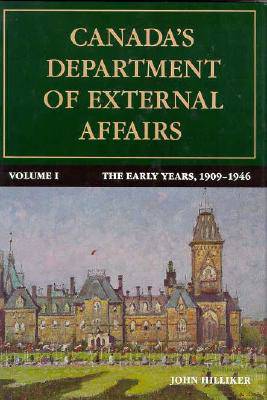
Je cadeautjes zeker op tijd in huis hebben voor de feestdagen? Kom langs in onze winkels en vind het perfecte geschenk!
- Afhalen na 1 uur in een winkel met voorraad
- Gratis thuislevering in België vanaf € 30
- Ruim aanbod met 7 miljoen producten
Je cadeautjes zeker op tijd in huis hebben voor de feestdagen? Kom langs in onze winkels en vind het perfecte geschenk!
- Afhalen na 1 uur in een winkel met voorraad
- Gratis thuislevering in België vanaf € 30
- Ruim aanbod met 7 miljoen producten
Zoeken
€ 177,45
+ 354 punten
Uitvoering
Omschrijving
After an introductory chapter dealing with the conduct of external relations before 1909, the book examines three distinct phases of the department's development. Although the department had modest beginnings under the first under-secretary, Sir Joseph Pope (1909-1925), it was seen by his successor, O.D. Skelton, as an important instrument for the assertion of Canadian autonomy. Skelton presided over the establishment of the first Canadian diplomatic missions abroad, and was responsible for the creation of a foreign service to staff them. With the outbreak of the war in 1939, both the responsibilities and the size of the department underwent substantial organizational change under Norman Robertson, who became under-secretary after Skelton's death in 1941. Taken together, the criteria for recruitment introduced by Skelton and the reorganization which took place under Robertson gave the department many of the features which have characterized it as a branch of the Canadian government. The further development of the institution will be examined in a second volume covering the years 1946-1968. Since the prime minister was secretary of state for External Affairs during much of the period covered by volume I, the book contributes to an understanding of the operation of the Canadian government as a whole as well as of a single department. It also examines the policy making process and therefore will be of interest to students of international relations as well as of public administration.
Specificaties
Betrokkenen
- Auteur(s):
- Uitgeverij:
Inhoud
- Aantal bladzijden:
- 440
- Taal:
- Engels
- Reeks:
- Reeksnummer:
- nr. 16
Eigenschappen
- Productcode (EAN):
- 9780773507364
- Verschijningsdatum:
- 1/01/1990
- Uitvoering:
- Hardcover
- Formaat:
- Genaaid
- Afmetingen:
- 164 mm x 238 mm
- Gewicht:
- 848 g

Alleen bij Standaard Boekhandel
+ 354 punten op je klantenkaart van Standaard Boekhandel
Beoordelingen
We publiceren alleen reviews die voldoen aan de voorwaarden voor reviews. Bekijk onze voorwaarden voor reviews.









